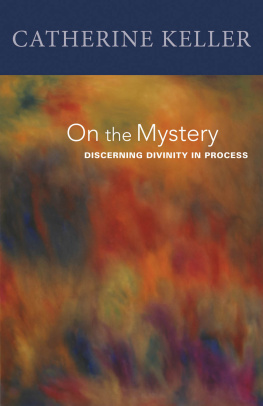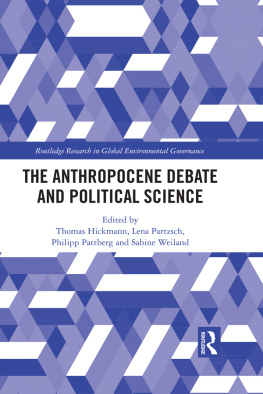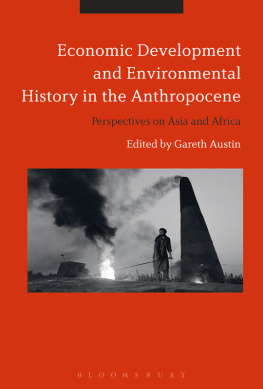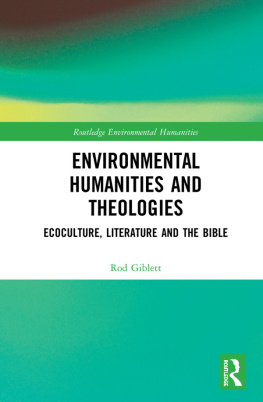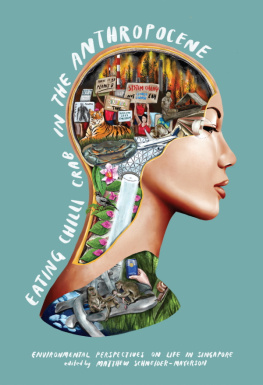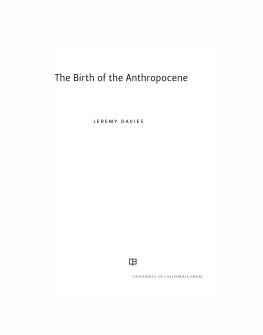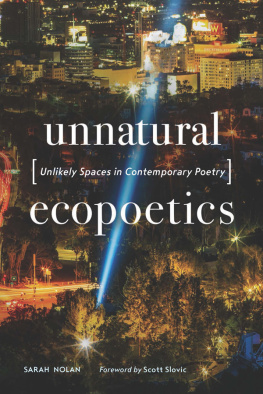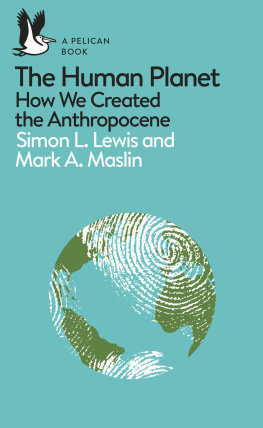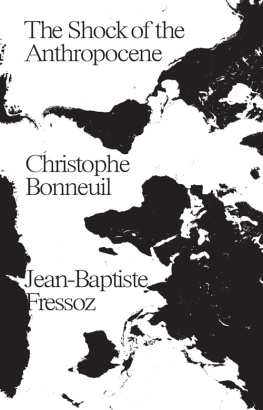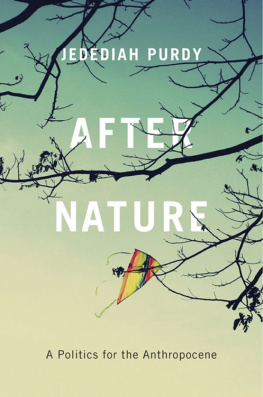Under the Sign of Nature: Explorations in Ecocriticism
Michael P. Branch, Kate Rigby, John Tallmadge, Editors
Recomposing Ecopoetics
NORTH AMERICAN POETRY OF THE SELF-CONSCIOUS ANTHROPOCENE
Lynn Keller
UNIVERSITY OF VIRGINIA PRESS
CHARLOTTESVILLE AND LONDON
University of Virginia Press
2017 by the Rector and Visitors of the University of Virginia
All rights reserved
Printed in the United States of America on acid-free paper
First published 2017
9 8 7 6 5 4 3 2 1
Library of Congress Cataloging-in-Publication Data
Names: Keller, Lynn, [date] author.
Title: Recomposing ecopoetics : North American poetry of the self-conscious anthropocene / Lynn Keller.
Other titles: North American poetry of the self-conscious anthropocene
Description: Charlottesville : University of Virginia Press, 2017. | Series: Under the sign of nature : explorations in ecocriticism | Includes bibliographical references and index.
Identifiers: LCCN 2017025188 | ISBN 9780813940618 (cloth : alk. paper) | ISBN 9780813940625 (pbk. : alk. paper) | ISBN 9780813940632 (ebook)
Subjects: LCSH: Ecocriticism. | Philosophy of nature in literature. | Place (Philosophy) in literature. | Ecology in literature. | Human-animal relationships in literature. | Environmentalism in literature. | American poetry21st centuryHistory and criticism. | Canadian poetry21st centuryHistory and criticism.
Classification: LCC PN98.E36 K45 2017 | DDC 809/.9336dc23
LC record available at https://lccn.loc.gov/2017025188
Cover art: Cut-Bank (Kikait), Jeremy Herndl, 2013. (Collection of the Surrey Art Gallery; photo by Scott Massey)
For Caroline and Joe
A poetics that can operate in the interrogative, with epistemological curiosity and ethical concern, is not so much language as instrument to peer through as instrument of investigative engagement. As such it takes part in the recomposing of contemporary consciousness, contemporary sensibilities.
Joan Retallack, What Is Experimental Poetry & Why Do We Need It?
Illustrations
Acknowledgments
Two communities have been crucial to the development of this book. The first is the Center for Culture, History, and Environment (CHE) in the Nelson Institute for Environmental Studies at the University of WisconsinMadison. When I turned my scholarship toward environmental inquiry, I started attending the regular CHE colloquia in order to learn how scholars in multiple disciplines were discussing environmental issues. I gained a great deal moremost rewardingly, an extraordinarily interesting and caring group of faculty and graduate student colleagues outside my home department of English. My particular thanks to Bill Cronon and Gregg Mitman, founding leaders of CHE, who pulled me in and have continued to support me.
The second is the English Department at Stockholm University, where I was a visiting professor in the first half of 2014. Claudia Egerer, then department chair, generously invited me to give a series of lectures for graduate students and faculty in lieu of one of my courses. Those lectures, which enabled me to gather the thinking I had been doing in recent years, provided the backbone for this book. I am grateful for the warm welcome I received from all the members of that department through Swedens dark winter months, and especially to Claudia, Bo Ekeland, and Paul Schreiber for their valuable feedback in response to my lectures.
Without composing the Stockholm lectures, I could never have written a proposal that would have convinced the John Simon Guggenheim Memorial Foundation to award me a fellowship. I am honored and grateful for the Guggenheim Fellowship in 20152016 that enabled me to write this book with the speed its timely subject warrants. Also formative was the interdisciplinary fall 2013 Faculty Development Seminar Environmental Studies in the Time of the Anthropocene, organized by Rob Nixon and sponsored by the Center for the Humanities, the Institute for Research in the Humanities, and the College of Letters and Science at the University of WisconsinMadison. I am grateful to Rob for his thoughtful leadership and to the other participants: Samer Alatout, Monique Allewaert, Anna Andrzejewski, Joshua Calhoun, Kata Beilin, Will Brockliss, Mark Johnson, Rick Keller, Gregg Mitman, Larry Nesper, Sai Suryanarayanan, Alberto Vargas, and Lydia Zepeda.
Many other wonderful friends and colleagues have also provided valuable assistance, among them Stephen Brick, Michael Davidson, Alan Golding, Caroline Levine, Angela Hume, Dee Morris, Jed Rasula, Joan Retallack, Jack W. Williams, and David Zimmerman. By inviting me to give talks in the spring of 2014, Marco Armiero, Evy Varsamopoulou, and Caitlin DeSilveyall generous hostsenabled me to get additional responses to ideas I was developing. Special thanks to the members of the stimulating ACLA seminar that Angela Hume and I organized in 2015, The Opening of the Field: New Approaches to Ecopoetics: Angie and Joan again, Rob Halpern, Matt Hooley, Michelle Niemann, Gillian Osborne, Sonya Posmentier, Margaret Ronda, Joshua Schuster, and Jonathan Skinner. I am deeply thankful for the powerful and courageous writing of all the poets discussed here; several of them deserve additional thanks for answering questions or providing resources. The person who has most helped me bring this book into the world is my former doctoral student Michelle Niemann, whom I hired initially so that I could have an informed and insightful reader responding to my chapters as I produced them during my fellowship year. Her comments prompted revisions that have significantly sharpened the arguments in this book. As she began to establish a business in academic editing, her responsibilities expanded: she commented on the revised chapters; helped me trim the manuscript; shifted the style to suit the presss stipulations; and properly formatted the notes along with the rest of the manuscript. Always prompt, efficient, and careful, as well as marvelously intelligent and sensible, she relieved me of a huge amount of labor and stress. A thousand thanks to Michelle.
I wish to acknowledge the poets, photographers, and presses who generously granted permission to reprint images from the books discussed here: Ian Teh and Coffee House Press; Jonathan Skinner and BlazeVOX; Evelyn Reilly, James Sherry, and Roof Books; Forrest Gander, Raymond Meeks, Lucas Foglia, and New Directions; Angela Rawlings, Matt Ceolin, and Coach House Books; Jody Gladding and Milkweed Editions. I am also grateful to the editors who published articles that overlap with material published here: 21st-Century Ecopoetry and the Scalar Challenges of the Anthropocene, in The News from Poems: Essays on the 21st-Century American Poetry of Engagement, edited by Jeffrey Gray and Ann Keniston; The Ecopoetics of Hyperobjects: Evelyn Reillys Styrofoam, in Interdisciplinary Studies in Literature and Environment; and a.rawlings: Ecopoetic Intersubjectivity, in Jacket2. Making Art under these apo-calypso rays: Crisis, Apocalypse, and Contemporary Ecopoetics, an abbreviated version of chapter 3, is forthcoming in a collection currently titled Ecopoetics: A Critical Anthology, edited by Angela Hume and Gillian Osborne.
My thanks to Boyd Zenner at the University of Virginia Press, to the manuscripts anonymous readers, and to the editors of the series Under the Sign of Nature, Michael Branch, SueEllen Campbell, Kate Rigby, and John Tallmadge, for their faith in this book. Thanks to the press staff, and especially to Ellen Satrom and Cecilia Sorochin, and to freelance editor Sue Breckenridge, for their skillful work on its production.
Finally, endless thanks to my amazing children, Caroline and Joe Carlsmith, whose love and energy support all that I do. However dark our time, they ground the hope that sustains me.
Next page





